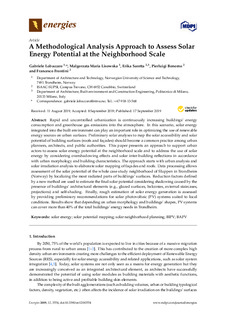| dc.contributor.author | Lobaccaro, Gabriele | |
| dc.contributor.author | Malgorzata, Maria Lisowska | |
| dc.contributor.author | Saretta, Erika | |
| dc.contributor.author | Bonomo, Pierluigi | |
| dc.contributor.author | Frontini, Francesco | |
| dc.date.accessioned | 2019-09-24T06:04:20Z | |
| dc.date.available | 2019-09-24T06:04:20Z | |
| dc.date.created | 2019-09-23T14:35:17Z | |
| dc.date.issued | 2019 | |
| dc.identifier.citation | Energies. 2019, 12 (18), 1-28. | nb_NO |
| dc.identifier.issn | 1996-1073 | |
| dc.identifier.uri | http://hdl.handle.net/11250/2618317 | |
| dc.description.abstract | Rapid and uncontrolled urbanization is continuously increasing buildings’ energy consumption and greenhouse gas emissions into the atmosphere. In this scenario, solar energy integrated into the built environment can play an important role in optimizing the use of renewable energy sources on urban surfaces. Preliminary solar analyses to map the solar accessibility and solar potential of building surfaces (roofs and façades) should become a common practice among urban planners, architects, and public authorities. This paper presents an approach to support urban actors to assess solar energy potential at the neighborhood scale and to address the use of solar energy by considering overshadowing effects and solar inter-building reflections in accordance with urban morphology and building characteristics. The approach starts with urban analysis and solar irradiation analysis to elaborate solar mapping of façades and roofs. Data processing allows assessment of the solar potential of the whole case study neighborhood of Sluppen in Trondheim (Norway) by localizing the most radiated parts of buildings’ surfaces. Reduction factors defined by a new method are used to estimate the final solar potential considering shadowing caused by the presence of buildings’ architectural elements (e.g., glazed surfaces, balconies, external staircases, projections) and self-shading. Finally, rough estimation of solar energy generation is assessed by providing preliminary recommendations for solar photovoltaic (PV) systems suited to local conditions. Results show that depending on urban morphology and buildings’ shapes, PV systems can cover more than 40% of the total buildings’ energy needs in Trondheim. | nb_NO |
| dc.language.iso | eng | nb_NO |
| dc.publisher | MDPI | nb_NO |
| dc.rights | Navngivelse 4.0 Internasjonal | * |
| dc.rights.uri | http://creativecommons.org/licenses/by/4.0/deed.no | * |
| dc.title | A Methodological Analysis Approach to Assess Solar Energy Potential at the Neighborhood Scale | nb_NO |
| dc.type | Journal article | nb_NO |
| dc.type | Peer reviewed | nb_NO |
| dc.description.version | publishedVersion | nb_NO |
| dc.source.pagenumber | 1-28 | nb_NO |
| dc.source.volume | 12 | nb_NO |
| dc.source.journal | Energies | nb_NO |
| dc.source.issue | 18 | nb_NO |
| dc.identifier.doi | 10.3390/en12183554 | |
| dc.identifier.cristin | 1727912 | |
| dc.description.localcode | © 2019 by the authors. Licensee MDPI, Basel, Switzerland. This article is an open access article distributed under the terms and conditions of the Creative Commons Attribution (CC BY) license (http://creativecommons.org/licenses/by/4.0/). | nb_NO |
| cristin.unitcode | 194,61,55,0 | |
| cristin.unitname | Institutt for arkitektur og teknologi | |
| cristin.ispublished | true | |
| cristin.fulltext | original | |
| cristin.qualitycode | 1 | |

